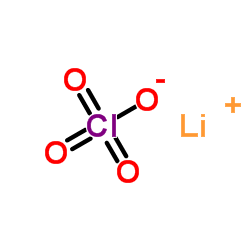Lithium perchlorate

Lithium perchlorate structure
|
Common Name | Lithium perchlorate | ||
|---|---|---|---|---|
| CAS Number | 7791-03-9 | Molecular Weight | 106.392 | |
| Density | 1.13 g/mL at 20 °C | Boiling Point | 430°C | |
| Molecular Formula | ClLiO4 | Melting Point | 236 °C(lit.) | |
| MSDS | Chinese USA | Flash Point | 400°C | |
| Symbol |


GHS03, GHS07 |
Signal Word | Danger | |
|
Novel organic solvents for electrochemistry at the liquid/liquid interface.
Analyst 140(6) , 1947-54, (2015) Two-phase voltammetry has been carried out using a reverse cell configuration, i.e. with the lower density organic solvent on the top of the aqueous solution in the cell, where the organic solvents contain either nitrile or ketone functional groups. The trans... |
|
|
A carbon nanotube/poly [Ni-(Protoporphyrin IX)] composite for amperometric detection of long chain aliphatic amines.
Bioelectrochemistry 104 , 51-7, (2015) Poly [Ni-Protoporphyrin] film (pNiPP), containing multiwall carbon nanotubes (MWCNT) was used to cover a glassy carbon electrode. The hybrid material (pNiPP/MWCNT) successfully combines the permselectivity of pNiPP with the high conductivity of MWCNT. The mod... |
|
|
Fabrication of Mesoporous CoS2 Nanotube Arrays as the Counter Electrodes of Dye-Sensitized Solar Cells.
Chem. Asian J. 10 , 1932-9, (2015) Mesoporous cobalt sulfide nanotube arrays on FTO-coated glass were synthesized by combining three simple technologies: the selective etching of ZnO sacrificial templates, mesoporous Co3 O4 formation from cobalt-chelated chitosan, and ion-exchange reaction (IE... |
|
|
Organocatalytic removal of formaldehyde adducts from RNA and DNA bases.
Nature Chemistry 7 , 752-8, (2015) Formaldehyde is universally used to fix tissue specimens, where it forms hemiaminal and aminal adducts with biomolecules, hindering the ability to retrieve molecular information. Common methods for removing these adducts involve extended heating, which can ca... |
|
|
General approach for electrochemical detection of persistent pharmaceutical micropollutants: Application to acetaminophen.
Biosens. Bioelectron. 72 , 205-10, (2015) We propose in this work a general and versatile methodology for electrochemical monitoring of persistent pharmaceutical micropollutants. The system presented is based on an electroactive and electropolymerized hapten (mimetic molecule of the pollutant to be d... |
|
|
Diamond nanowires modified with poly[3-(pyrrolyl)carboxylic acid] for the immobilization of histidine-tagged peptides.
Analyst 139(17) , 4343-9, (2014) Coating boron-doped diamond nanowires (BDD NWs) with a conducting polymer, poly[3-(pyrrolyl)carboxylic acid], has been reported. Polymer coating was achieved through electropolymerization of 3-(pyrrolyl)carboxylic acid at the electrode interface by amperometr... |
|
|
Decolorization and mineralization of Allura Red AC aqueous solutions by electrochemical advanced oxidation processes.
J. Hazard. Mater. 290 , 34-42, (2015) The decolorization and mineralization of solutions containing 230 mg L(-1) of the food azo dye Allura Red AC at pH 3.0 have been studied upon treatment by electrochemical oxidation with electrogenerated H2O2 (EO-H2O2), electro-Fenton (EF) and photoelectro-Fen... |
|
|
Treatment of a mixture of food color additives (E122, E124 and E129) in different water matrices by UVA and solar photoelectro-Fenton.
Water Res. 81 , 178-87, (2015) The degradation of 130 mL of mixtures of food azo dyes E122, E124 and E129 has been studied by electro-Fenton (EF) and UVA photoelectro-Fenton (PEF) using a stirred tank reactor with either a boron-doped diamond (BDD) or Pt anode and an air-diffusion cathode.... |
|
|
An Organic Catalyst for Li-O2 Batteries: Dilithium Quinone-1,4-Dicarboxylate.
ChemSusChem 8 , 2198-203, (2015) Solid organic electrocatalysts have hardly been tested in Li-O2 batteries. Here, a new solid organic electrocatalyst, dilithium quinone-1,4-dicarboxylate (Li2 C8 H2 O6 ) is presented, which is expected to overcome the shortcomings of inorganic catalysts. The ... |
|
|
Improvement in glucose biosensing response of electrochemically grown polypyrrole nanotubes by incorporating crosslinked glucose oxidase.
Mater. Sci. Eng. C. Mater. Biol. Appl. 55 , 420-30, (2015) In this paper a novel enzymatic glucose biosensor has been reported in which platinum coated alumina membranes (Anodisc™s) have been employed as templates for the growth of polypyrrole (PPy) nanotube arrays using electrochemical polymerization. The PPy nanotu... |